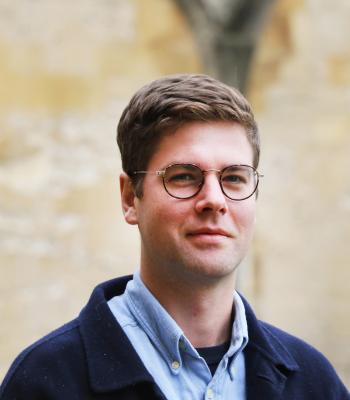Qualifications
MA History of Art (Cambridge); MPhil History of Art (Cambridge); PhD History of Art (York)
Academic background
I studied History of Art at the University of Cambridge as an undergraduate and at MPhil level, later becoming Assistant Curator at the Royal Collection Trust. I completed a PhD in early Netherlandish painting at the University of York (incorporating a brief placement at the University of Cologne), continuing my Royal Collection curatorial work on a part-time basis. Since then, I have been Curatorial Intern in the Paintings Department at the J. Paul Getty Museum and an Alexander von Humboldt Foundation Postdoctoral Fellow at the Freie Universität, Berlin.
I will be spending May to July 2025 at the Institut für Geschichtswissenschaften of the Humboldt University, Berlin, on an Oxford Berlin Research Partnership fellowship.
Research interests
My research interests lie in late medieval and early modern art, spanning Germany, the Low Countries, France, Italy and England. My current research project, entitled 'Image Rights', looks at the legal resonances of late medieval facial representation.
Images of individuals have had a long history of lawful significance, dating to the Roman ‘right to representations’. Painted portraits, however, emerged only c. 1350 and were used initially for subjects with legitimate claims to portrayals (like monarchs). For the image-commissioning population—often educated or actively involved in law—and for artists alike, the new portrait genre established itself within a web of rights, controls, and official capacities. My research therefore takes into consideration the various active legal-visual dimensions across material culture (seals, letters, coins) to conceptualise the early portrait as a complex visual sign, uniting text, insignia and figure.
My PhD thesis, 'From Shrine to Room: An Interpretation of the House Interior in Early Netherlandish Panel Painting c.1400-1450' (2021), looks at the introduction of the 'realistic' domestic interior into northern painting. My case studies range from late medieval pre-Eyckian painting’s ‘micro-architectural’ tendencies to the mid-15th-century emergence of the ‘milieu portrait’ in Petrus Christus’ oeuvre; when pictorial background was converted into social background. These developments help us to understand the emergence of the interior scene, that significant genre, which continues to serve multiple purposes in image-making right up to the present day.
As well as continuing to publish 17th-century primary materials relating to the history of the royal collection––most recently, on Artemisia Gentileschi's time in England––I work on a long-term collaborative digital project on Charles I, cited below. It provides a 3D reconstruction of several rooms at Whitehall Palace c. 1639 and republishes the collection inventories online, tracing the locations of many significant early modern paintings previously thought lost. I also have a strong interest in the historical theory and historiography of art.
Featured publications
'Review of Exhibitions: Hugo van der Goes. Between Pain and Bliss (Gemäldegalerie–Staatliche Museen zu Berlin, March 31-July 16, 2023). Catalogue by Stephan Kemperdick and Erik Eising with the Collaboration of Till-Holger Borchert', Renaissance Studies, 38, no. 2 (April 2024), pp. 321–9 [https://doi.org/10.1111/rest.12920].
'Artemisia Gentileschi’s "Susanna and the elders" painted for Henrietta Maria', The Burlington Magazine 165, no. 1447 (October 2023), pp. 1053–73 [with Adelaide Izat].
'Bernardo Bellotto, View of the Santa Maria della Salute and the Dogana from Campo Santa Maria Zobenigo', in Bernardo Bellotto. W 300. rocznicę urodzin malarza, Eds. Artur Bardach and Magdalena Królikiewicz (Warsaw: The Royal Castle in Warsaw, 2022), pp. 125–27.
'Essay: Bernardo Bellotto, View of the Santa Maria della Salute and the Dogana from Campo Santa Maria Zobenigo', curatorial essay on the J. Paul Getty Museum Website (July 2022) [https://museum-essays.getty.edu/paintings/nmunz-bellotto/].
'Review: Gothic Sculpture by Paul Binski' [review article], Sculpture Journal 30, no. 1 (2021), pp. 87–92.
'The Lost Collection of Charles I', Royal Collection Trust (2018–19), https://lostcollection.rct.uk [digital project].
Catalogue entries [nos. 34, 39, 40–1, 43, 62–3, 69, 71, 73, 105–6, 130–34, 136] in Charles I: King and Collector, eds. Per Rumberg and Desmond Shawe-Taylor (London: Royal Academy of Art, 2018), pp. 238–9, 242–4, 249–50, 253–4.
'Charles I’s Picture Collection: A Digital Initiative', The Burlington Magazine 159, no. 1374 (2017), pp. 692.
'Canaletto and Neo-Palladianism', and catalogue entries [nos. 146–50], in Canaletto and the Art of Venice, eds. Lucy Whitaker and Rosie Razzall (London: Royal Collection Trust, 2017), pp. 279–83, 300–09.
Catalogue entries [nos. 3, 4, 82, 115, 120] in Portrait of the Artist, eds. Anna Reynolds, Lucy Peter and Martin Clayton (London: Royal Collection Trust, 2016), pp. 42–43, 142, 195, 200.
Royal Collection Trust research project
Explore the Royal Collection Trust digital research project on Charles I's historic collection, led by Niko.

